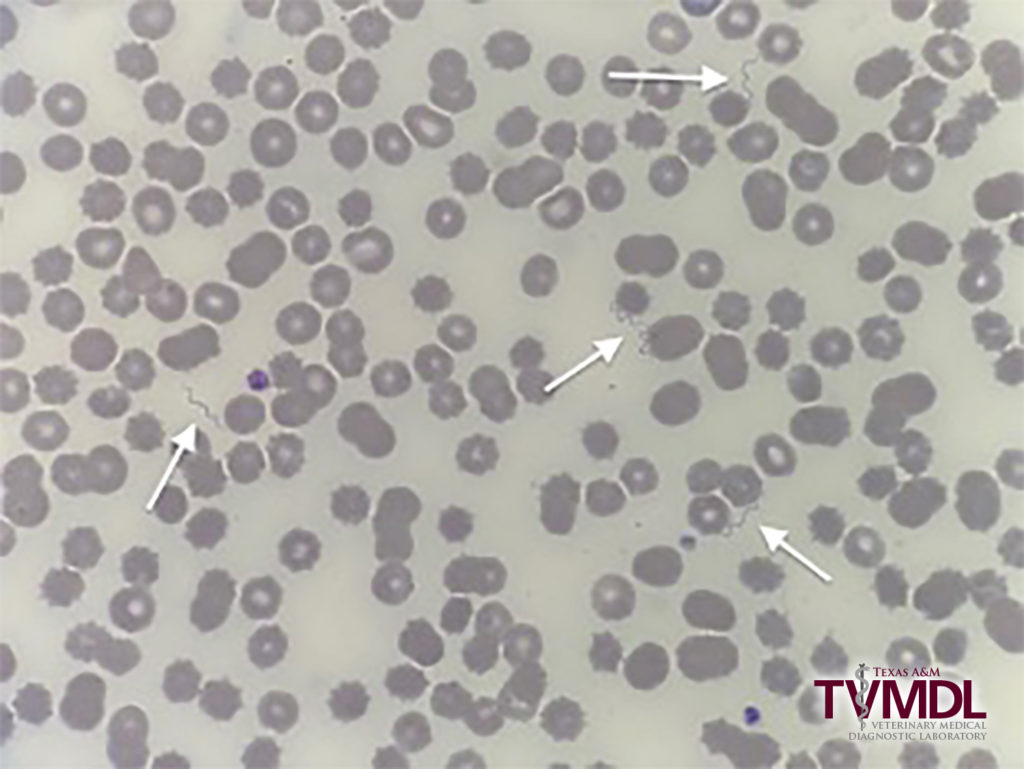Tick-Borne Relapsing Fever diagnosed in Brazos Valley dog
Caitlin Wampler and Julie Piccione, DVM, MS, DACVP
A 7-year-old, female spayed, Soft Coated Wheaten Terrier from the Brazos Valley region of Texas presented to the veterinarian for lethargy and decreased appetite. The clinic found there was mild anemia and a low platelet count at 32K/µL (RI: 200-500K/µL). The veterinarian reviewed a blood smear in the clinic and noted hemoparasites. Peripheral blood was submitted to the Texas A&M Veterinary Medical Diagnostic Laboratory (TVMDL) for a hemoparasite exam and possible Borrelia spp. PCR testing.
A wedge prep peripheral blood smear was prepared and stained with a Wright-Giemsa automated stainer. When scanning the peripheral blood smear, many faint, purple spirochete bacteria were visible at 100x, along with a visibly decreased platelet count (Figure 1). Borrelia spp. rtPCR was then run and DNA from B. turicatae was detected with the cycle thresholds (Ct) being 21.6. According to TVMDL’s molecular laboratory, samples with a Ct value 1.0-28.0 indicate the presence of abundant amounts of target nucleic acid; samples with a Ct value of 28.1-35.0 indicate moderate amounts of target nucleic acid; samples with a Ct value of 35.1-40-45.0 indicate minimal amounts of target nucleic acid.
Borrelia is a genus of spirochete bacteria that are the causative agents of many diseases that affect dogs, such as Lyme disease and Tick-Borne Relapsing Fever (TBRF). The species of Borrelia that cause TBRF in the U.S., primarily B. hermsii and B. turicatae, are spread by the genus Ornithodoros of soft ticks. Unlike hard ticks, soft ticks only stay attached to the host for a limited amount of time, minutes rather than days, and almost exclusively feed at night. The spirochete bacteria are in the saliva of the tick and are introduced to the host while feeding. Given the behavior of the soft tick, paired with the absence of definitive clinical signs, TBRF can be difficult to diagnose. The species of Borrelia that cause TBRF are the only species where spirochetes are frequently visible in a peripheral blood, therefore a diagnosis of TBRF can be made when they are seen. However, it has become easier to diagnose with advances in PCR.
TBRF has been reported in other parts of Texas, but this case is the first to be reported in College Station. Case reporting is most active in the warmer months, May-September. Some clinical signs of TBRF can include; lethargy, fever, postural/ambulatory disorders, and inappetence. In addition, thrombocytopenia is often seen with the visible spirochetes. Prognosis for a dog with TBRF is relatively good, but there aren’t many reported cases due to it being under diagnosed.
